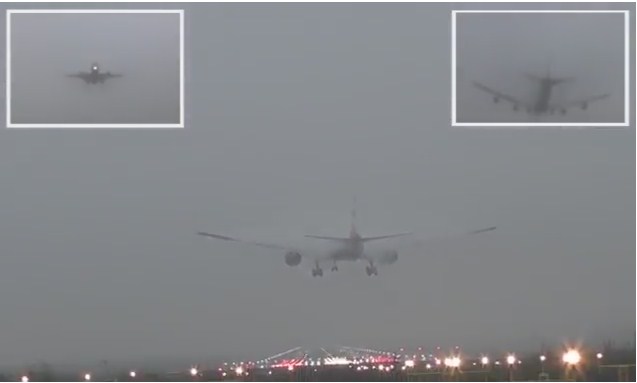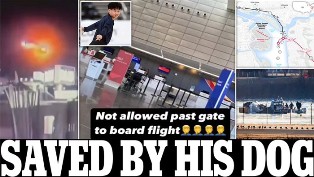Pilot Hebat! Nekat Tembus di Bandara Gatwick London
Incredible Planes Landing at London`s Gatwick Airport Despite Dense Fog
Editor : Ismail Gani
Translator : Novita Cahyadi

KABUT pada Selasa di sekitar bandara Gatwick London sangat pekat - namun itu tidak menghentikan pesawat yang ingin mendarat, seperti ditunjukkan pada rekaman luar biasa ini.
Pada video klip terlihat pesawat muncul dari kabut putih pekat sebelum mendarat sementara pesawat menuju landasan yang baru terlihat sesaat sebelum pesawat menyentuh tanah.
Menurut pembuat film, TopFelya, jarak pendek sangat minim sehingga beberapa pesawat benar-benar terpaksa memutar sebelum mendarat atau mengalihkan ke bandara lain.
Dalam beberapa kasus, tambahnya, pesawat harus membatalkan pendaratan dan 'berputar' sesuai prosedur.
Dia mengatakan: 'Perilaku alam dikenal sebagai "radiasi kabut" dan biasanya terjadi pada jam-jam sebelum matahari terbit ... tapi pada kejadian tertentu bisa berlangsung sepanjang hari.'
Menurut Plane Clever, oleh Christopher Bartlett, pesawat modern dapat 'mendarat hampir secara otomatis meski di tengah kabut', tetapi pengendali lalu lintas udara lebih faham akan kelayakan cuaca bagi pesawat untuk mendarat dan lepas landas.
Kevin O'Donnell, Manajer Operasional Penerbangan pada Zenith Aviation, mengatakan bahwa dalam kondisi yang sangat berkabut, pilot lebih mengandalkan instrumen mereka.
Dia mengatakan kepada Travel MailOnline: "Saya telah melakukan banyak pendaratan di tengah dengan jet komersial besar selama karir saya dan jarak pandang kurang dari 100 meter."
'Pilot biasanya mengalihkan pemindaian dari instrumen di kokpitke dunia luar ketika mendarat dalam cuaca yang wajar, namun dalam kabut yang menutupi pandangan ke landasan pilot dilatih untuk fokus pada terbatasnya jarak pandang.'
'Pilot memantau integritas sistem pesawat mengandalkan cakrawala buatan dan instrumen sistem pendaratan untuk memastikan bahwa pesawat berada di garis tengah dan di jalur mendarat yang tepat.
'Teknologi menggantikan indera manusia dan pilot membenamkan diri dalam dunia buatan saat bersiap melakukan pendaratan.
'Sebagai pilot Anda dilatih untuk meyakini kemampuan instrumen penerbangan dan ini diuji ekstrim seperti Anda mengontrol kendali benda berbobot ratusan ton untuk mendarat.
"Meskipun seluruh urutan kejadian otomatis kemungkinan besartapi sistem harus direncanakan dan pilot dilatih di simulator terbang untuk mengambil keputusan jika tidak berjalan sesuai rencana.
"Kami terbang di awan tinggi di atas langit sebagai norma tetapi keterampilan dan konsentrasi kita sangat terfokus pada awan yang menutupi landasan."
Steve Landells, spesialis keamanan penerbangan untuk Association Airline Pilot Inggris, mengatakan: "Dalam kondisi berkabut pilot mungkin harus menggunakan sistem autoland pesawat. Namun, ini adalah prosedur yang kompleks dan sementara pilot telah dilatih menggunakan fungsi ini yang hanya akan digunakan jika benar-benar diperlukan dan pilot akan selalu siap mengambil alih kontrol apabila gagal."
'Bandara perlu memiliki perlindungan khusus di tempat untuk mengatasi autoland dan lebih banyak waktu diperlukan untuk mendapatkan pesawat dengan aman ke atau dari landasan pacu, jadi ini adalah mengapa jumlah take-off dan pendaratan secara signifikan terpengaruh selama cuaca berkabut.'
Video telah dilihat lebih dari 25.000 kali di YouTube, dan banyak terkesan pada keterampilan sang pilot seperti dilansir MailOnline.
TheHDAviation menulis: 'rekaman yang mengagumkan. Pasti hari yang menantang untuk merekam video penerbangan ini.'
Canadian Aviation Film bilang: 'Rekaman video mengesankan rekaman ... hasilnya sangat bagus.'
Dan Casey Planespotting menulis: 'Kabut adalah sesuatu yang mengancam keselamatan penerbangan."
ON TUESDAY the fog around London’s Gatwick airport was incredibly dense – but that didn’t stop the planes landing, as this remarkable footage shows.
On the clip airliners appear out of a wall of white before touching down while others are filmed taxiing and taking off into a giant bank of mist.
According to the filmmaker, TopFelya, visibility was so poor that some planes were actually forced to circle before landing or divert to another airport.
In some instances, he added, planes had to abort the landings in a ‘go around’ procedure.
He said: ‘This act of nature is known as “radiation fog” and usually takes place in the hours before sunrise… but this particular occurrence lasted for the whole day.’
According to Plane Clever, by Christopher Bartlett, modern airliners can ‘land virtually automatically in fog’, but the air traffic controllers will space the aircraft out more as they land and depart.
Kevin O'Donnell, Flight Operations Manager for Zenith Aviation, said that in very misty conditions, pilots rely more than ever on their instruments.
He told MailOnline Travel: 'I have executed numerous landings in fog on large commercial jets during my career often in visibility less than 100 metres (328 feet).
'The pilot normally transfers his scan from the instrument world of his flightdeck to the outside world when landing in reasonable weather, however in fog the runway picture that pilots are trained to focus on is unavailable.
'The pilots monitor the integrity of the aircraft systems relying on the artificial horizon and the instrument landing system to ensure that the aircraft is on the centreline and on the correct glide slope.
'Technology replaces the human senses and the pilots immerse themselves in an artificial world all the way down to the ground.
'As a pilot you are trained to believe the flight instruments and this is tested to the extreme as you control a few hundred tonnes of jet onto the runway.
'Although the whole sequence of events is automated the possibility of a systems failure has to be planned and pilots are trained in simulators to fly a missed approach if things don't go according to plan.
'We fly in clouds high above the sky as the norm but our skill and concentration are very focussed when that cloud is on the ground.'
Steve Landells, flight safety specialist for the British Airline Pilots Association, said: 'In foggy conditions pilots may have to use the aircraft’s autoland system. However, this is a complex procedure and while pilots are thoroughly trained in this function it will only be used if absolutely necessary and the pilot will always be at the control ready to take over should it fail.
'Airports need to have special protections in place to cope with autoland and more time is needed to get aircraft safely to or from the runway, so this is why the amount of take-offs and landings are significantly affected during foggy weather.'
The video has been viewed over 25,000 times on YouTube, with many impressed by the filming and the skill of the pilots.
TheHDAviation wrote: ‘Awesome foggy footage. Must have been a challenging day for filming and flying.’
Canadian Aviation Films said: ‘Impressive footage… nice filming.’
And Casey Planespotting wrote: ‘That fog was something else.’















